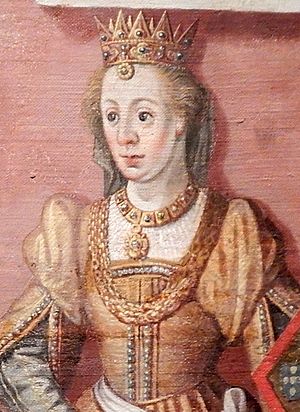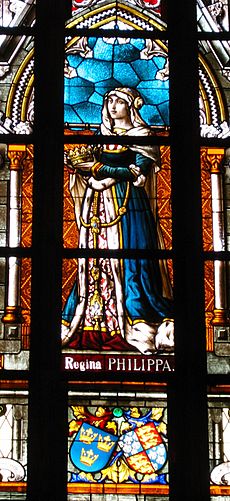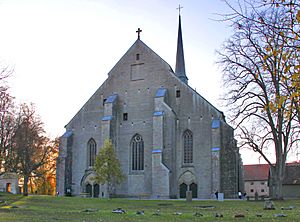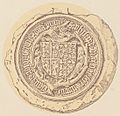Philippa of England facts for kids
Quick facts for kids Philippa of England |
|
|---|---|

Queen Philippa as portrayed in the 1590s by Cornelius Krommeny
|
|
| Queen consort of Denmark, Sweden, and Norway |
|
| Tenure | 26 October 1406 - 5 January 1430 |
| Born | mid-1394 Peterborough Castle, England |
| Died | 5 January 1430 (aged 35) Vadstena Abbey, Sweden |
| Burial | Cloister Church at Vadstena, Linköping |
| Spouse | Eric, King of Denmark, Sweden, and Norway |
| House | Lancaster |
| Father | Henry IV, King of England |
| Mother | Mary de Bohun |
Philippa of England (born mid-1394 – died 5 January 1430) was a queen who ruled over three countries. She was also known as Philippa of Lancaster. From 1406 to 1430, she was the Queen of Denmark, Norway, and Sweden. She became queen by marrying King Eric of Pomerania. Eric was the ruler of the Kalmar Union, which joined these three kingdoms.
Philippa was the daughter of King Henry IV of England. Her mother was Mary de Bohun. She was also the younger sister of King Henry V. Queen Philippa was very involved in running the country. She even served as the regent (a temporary ruler) of Denmark from 1423 to 1425.
Contents
Becoming a Queen: Philippa's Journey
Early Life and Family
Philippa was born at Peterborough Castle in Peterborough, England. Her parents were Henry Bolingbroke and Mary de Bohun. Her father became King of England in 1399.
When she was a child, she went on a special trip to Canterbury. She mostly lived at Berkhamsted Castle and Windsor Castle.
Marriage and Royal Wedding
Around 1400, King Henry IV suggested a special plan. He wanted to form an alliance between England and the Kalmar Union. This would happen through two royal weddings.
One wedding would be between his daughter Philippa and Eric of Pomerania. Eric was the future king of the Nordic countries. The other wedding would be between Henry's son, Henry, and Eric's sister, Catherine.
Queen Margaret I of Denmark did not agree to all the terms. So, the marriage between Henry and Catherine never happened. But in 1405, a group of people from the three Nordic kingdoms came to England. They announced that Philippa and Eric would marry.
On November 26, 1405, Philippa married Eric in a special ceremony. Eric was not there in person. A Swedish nobleman, Ture Bengtsson Bielke, stood in for him. On December 8, she was officially named Queen of Denmark, Norway, and Sweden.
Philippa left England in August 1406. She sailed from Lynn with many English nobles. She arrived in Helsingborg in September. There, Eric and Queen Margaret welcomed her.
The wedding between Philippa and Eric took place on October 26, 1406. It was held in Lund Cathedral. Philippa was the first princess known to wear a white wedding dress for a royal wedding. Her dress was a white silk tunic and cloak. It was decorated with grey squirrel and ermine fur.
After the wedding, she was crowned queen. The celebrations lasted until November. Philippa also received lands in all three kingdoms. These lands were in Sweden, Denmark, and Norway.
Queen and Regent: Philippa's Role
Life as Queen
Queen Philippa and King Eric lived in Kalmar Castle in Sweden for the first three years of their marriage. Philippa had her own royal court. Lady Katarina Knutsdotter, a granddaughter of Saint Bridget of Sweden, was her chief lady-in-waiting.
After 1409, and especially after Queen Margaret died in 1412, Eric became the full king. The royal couple then mostly lived in Denmark. However, Philippa often returned to Sweden. She had a special connection to Sweden because she lived there early in her marriage.
Philippa's Connection to Vadstena Abbey
Philippa was very interested in Vadstena Abbey in Sweden. This abbey became a safe place for her. It was also her base whenever she was in Sweden.
In 1415, some nuns and monks from Vadstena Abbey went to England. They helped start a new monastery there called Syon Abbey. Philippa probably visited Vadstena for the first time in 1408.
She made donations to the Abbey. She also helped protect the Bridgettine Order. When the Pope tried to ban certain monasteries, Queen Philippa and Eric sent people to Rome. They asked for the ban to be removed for the Bridgettine Order.
Taking on Royal Responsibilities
Queen Philippa was very active in state affairs. King Eric trusted her a lot. In 1416, Eric named his cousin Bogusław IX as his heir if he and Philippa had no children. In 1420, this plan was changed. Philippa was given an important role. If Eric died, Queen Philippa would become the regent until Bogusław could become king. If Bogusław was too young, Philippa would rule until he was old enough.
Philippa's lands in Sweden were also changed. She was given a large area in Central Sweden to rule. This showed how much Eric trusted her.
Many people, both then and now, praised her rule. They said she was sometimes even more effective than Eric. Her large lands in Sweden made her more interested in that kingdom. While Eric preferred Denmark, Philippa often visited Sweden for long periods. She acted as Eric's representative there. This meant she was the unofficial ruler of Sweden for much of the 1420s.
In 1422, she led a meeting of important people in Vadstena. She helped settle a disagreement between noble groups. Eric often gave her power to handle Swedish matters.
Regent of the Three Kingdoms
From 1423 to 1425, King Eric went on a special trip. During this time, Queen Philippa served as the regent for all three kingdoms from Copenhagen. In 1424, she solved a problem with the Hanseatic League. This was a group of powerful trading cities. She created new rules for their money system. During her time as regent, she also called a meeting of the Swedish Council in Stockholm in 1425.
In 1426, Philippa went to Sweden. She gathered the Swedish council in Vadstena. She managed to get their support and money for the Dano-Hanseatic War (1426–35). This was despite many Swedes being against the war. In 1427, she again got Swedish support for Eric's war.
In March 1427, she returned to Denmark. She stayed there for three years during the war. In 1428, Philippa bravely organized the defense of Copenhagen. The Hanseatic League attacked the city during the 1428 bombardment. She was seen as a hero by the people of Copenhagen. She encouraged everyone to fight the Hanseatic fleet in the harbor.
In late 1429, Philippa went to Sweden. Her official task was to get more support for Eric's war. In Sweden, she traveled to Vadstena Abbey. There, she was welcomed by Swedish leaders. Soon after arriving, she became ill. This was a sickness that had affected her before.
Her health got worse, and she died on January 5, 1430. She was 35 years old. She was buried in the Cloister Church at Vadstena, near Linköping in Östergötland, Sweden. She left several gifts to Vadstena Abbey in her will.
Philippa's Lasting Impact
- Philippa is remembered as one of the few royals of the Kalmar Union who was popular outside Denmark. In Sweden, people often praised her. They saw her as a good contrast to King Eric, who was not always liked.
- Her brave defense of Copenhagen in 1428 was famously told by Hans Christian Andersen. It appeared in his book Godfather's Picture Book (1868).
- She is played by actress Thomasin McKenzie in the movie The King.
- In the Danish movie Margrete: Queen of the North, child actress Diana Martinová plays her.
Images for kids
|
Philippa of England
Born: 1394 Died: 7 January 1430 |
||
| Royal titles | ||
|---|---|---|
| Vacant
Title last held by
Helvig of Schleswig |
Queen consort of Denmark 1406–1430 |
Vacant
Title next held by
Dorothea of Brandenburg |
| Vacant
Title last held by
Margaret I of Denmark |
Queen consort of Norway 1406–1430 |
|
| Vacant
Title last held by
Richardis of Schwerin |
Queen consort of Sweden 1406–1430 |
|







